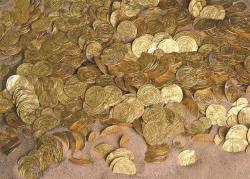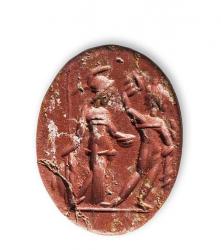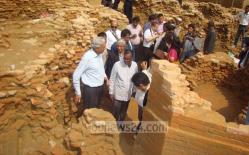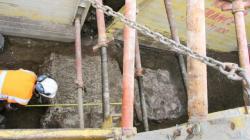INSTITUT SUPERIEUR D'ANTHROPOLOGIE
INSTITUTE OF ANTHROPOLOGY
ONLINE COURSES / COURS A DISTANCE
SPRING TERM : APRIL 2015
REGISTER NOW
ISRAEL -  Caesarea - Scuba divers have discovered the largest trove of gold coins ever found off Israel’s Mediterranean coast, about 2,000 pieces dating back more than 1,000 years, the country’s antiquities authority said on Feb. 17. It was by pure chance that members of a diving club in the Roman-era port had come across the coins, which the authority said weighed nine kilograms but described as “priceless.” “At first they thought they had spotted a toy coin from a game and it was only after they understood the coin was the real thing that they collected several coins and quickly returned to the shore in order to inform the director of the dive club about their find,” a statement said. Experts from the authority called to the site uncovered “almost 2,000 gold coins in different denominations” circulated by the Fatimid Caliphate, which ruled much of the Middle East and North Africa from 909 to 1171. Kobi Sharvit, director of the marine archaeology unit at the Israel Antiquities Authority, said excavations would be carried out in the hope of shedding more light on the origin of the treasure. “There is probably a shipwreck there of an official treasury boat which was on its way to the central government in Egypt with taxes that had been collected,” said Sharvit. “Perhaps the treasure of coins was meant to pay the salaries of the Fatimid military garrison which was stationed in Caesarea and protected the city. “Another theory is that the treasure was money belonging to a large merchant ship that traded with the coastal cities and the port on the Mediterranean Sea and sank there,” he said. The Israeli Antiquities Authority declined to put a cash value on the coins, which it said had been exposed as a result of winter storms.
Caesarea - Scuba divers have discovered the largest trove of gold coins ever found off Israel’s Mediterranean coast, about 2,000 pieces dating back more than 1,000 years, the country’s antiquities authority said on Feb. 17. It was by pure chance that members of a diving club in the Roman-era port had come across the coins, which the authority said weighed nine kilograms but described as “priceless.” “At first they thought they had spotted a toy coin from a game and it was only after they understood the coin was the real thing that they collected several coins and quickly returned to the shore in order to inform the director of the dive club about their find,” a statement said. Experts from the authority called to the site uncovered “almost 2,000 gold coins in different denominations” circulated by the Fatimid Caliphate, which ruled much of the Middle East and North Africa from 909 to 1171. Kobi Sharvit, director of the marine archaeology unit at the Israel Antiquities Authority, said excavations would be carried out in the hope of shedding more light on the origin of the treasure. “There is probably a shipwreck there of an official treasury boat which was on its way to the central government in Egypt with taxes that had been collected,” said Sharvit. “Perhaps the treasure of coins was meant to pay the salaries of the Fatimid military garrison which was stationed in Caesarea and protected the city. “Another theory is that the treasure was money belonging to a large merchant ship that traded with the coastal cities and the port on the Mediterranean Sea and sank there,” he said. The Israeli Antiquities Authority declined to put a cash value on the coins, which it said had been exposed as a result of winter storms.
http://www.hurriyetdailynews.com/record-trove-of-gold-coins-in-mediterranean.aspx?pageID=238&nID=78528&NewsCatID=375
NORVEGE –  Stokke - “Brunstad man”, whose remains were found in Stokke, south of Oslo, is now believed to be from the Mesolithic period, which spans from 10,000BC-4000BC) “The discovery is sensational in Norwegian, and indeed even in a north European context,” Almut Schülke, an archaeologist working for the Museum of Cultural History at the University of Oslo, told Aftenposten journalists when they visited the laboratory where the find is being analysed on Monday. “It is very seldom that we find bones from the stone age.” The skeleton is in an extremely fragile condition, meaning researchers are painstakingly examining it tiny fragment by tiny fragment, documenting the location of everything as accurately as possible and feeding it into a 3-D computer model of the find. The archaeologists hope to learn the age of the man, his diet and the extent to which the people who found their way so far north had contact with other settlements around the Skagerrak and the Baltic Sea. The skeleton was found lying in the fetal position, a typical stone-age burial position, in a pit which had been bricked in on the inside. The researchers had to divide the skeleton and the surrounding soil into eight parts to remove it from the earth and bring it back to the archeological laboratory in Oslo. Schülke told the newspaper she hoped to find further evidence of human activity at the same site. “We do not know if Brunstad was a fixed settlement or whether it was a place people went to pick up special resources, such as different types of stone,” she told the newspaper. “We do not know of other major tombs nearby, but it was not uncommon to add a single grave so close to a settlement, as they have done here.”
Stokke - “Brunstad man”, whose remains were found in Stokke, south of Oslo, is now believed to be from the Mesolithic period, which spans from 10,000BC-4000BC) “The discovery is sensational in Norwegian, and indeed even in a north European context,” Almut Schülke, an archaeologist working for the Museum of Cultural History at the University of Oslo, told Aftenposten journalists when they visited the laboratory where the find is being analysed on Monday. “It is very seldom that we find bones from the stone age.” The skeleton is in an extremely fragile condition, meaning researchers are painstakingly examining it tiny fragment by tiny fragment, documenting the location of everything as accurately as possible and feeding it into a 3-D computer model of the find. The archaeologists hope to learn the age of the man, his diet and the extent to which the people who found their way so far north had contact with other settlements around the Skagerrak and the Baltic Sea. The skeleton was found lying in the fetal position, a typical stone-age burial position, in a pit which had been bricked in on the inside. The researchers had to divide the skeleton and the surrounding soil into eight parts to remove it from the earth and bring it back to the archeological laboratory in Oslo. Schülke told the newspaper she hoped to find further evidence of human activity at the same site. “We do not know if Brunstad was a fixed settlement or whether it was a place people went to pick up special resources, such as different types of stone,” she told the newspaper. “We do not know of other major tombs nearby, but it was not uncommon to add a single grave so close to a settlement, as they have done here.”
http://www.thelocal.no/20150216/stone-age-skeleton-found-in-summer-judged-norways-oldest
ROYAUME UNI –  Whitchurch - Archaeologists in the U.K. have revealed a decorated bronze jug handle, a Samian ware cup, and a burial urn from the second-century C.E. burial site of a wealthy Roman. A group of "Weekend Wanderers" found the artifacts by accident when exploring a Whitchurch field with metal detectors.After the metal detectorist noted the find, experts from Oxford Archaeology unearthed the bronze handle, along with a cremation casket and even the remains of food and drink, during an excavation in October. The excavation also revealed a red jasper intaglio ring depicting Minerva and Mercury. The bronze handle and decorated cup are the most important finds from the site, the archaeologists noted.The variety of pottery remains, which included the Samian cup as well as glass vessels, a bronze dish, and an iron lamp, along with the burial urn, signified that the burial site was likely for an adult of high status.
Whitchurch - Archaeologists in the U.K. have revealed a decorated bronze jug handle, a Samian ware cup, and a burial urn from the second-century C.E. burial site of a wealthy Roman. A group of "Weekend Wanderers" found the artifacts by accident when exploring a Whitchurch field with metal detectors.After the metal detectorist noted the find, experts from Oxford Archaeology unearthed the bronze handle, along with a cremation casket and even the remains of food and drink, during an excavation in October. The excavation also revealed a red jasper intaglio ring depicting Minerva and Mercury. The bronze handle and decorated cup are the most important finds from the site, the archaeologists noted.The variety of pottery remains, which included the Samian cup as well as glass vessels, a bronze dish, and an iron lamp, along with the burial urn, signified that the burial site was likely for an adult of high status.
http://www.theweek.com/speedreads/539790/archaeologists-reveal-2ndcentury-bronze-relics-accidentally-discovered-by-metal-detectorist
NEPAL – Gorkha - Laprang Gumba, a 700-year-old Buddhist monastery at Samagaun VDC in Gorkha, was destroyed in a massive fire on Monday evening. Authorities said ancient manuscripts, Buddha idols, silver coins and other valuables worth around Rs 150 million were lost in the fire. The monastery is situated in one of the most remote parts of Gorkha, some 166 kilometres from the district headquarters.
http://www.ekantipur.com/the-kathmandu-post/2015/02/17/top-stories/centuries-old-gorkha-monastery-in-flames/273311.html
BANGLADESH –  Nateshwar - An estimated thousand-year-old Buddhist city has been discovered seven metres beneath the ground at Nateshwar in Munshiganj. The Director of Archaeological Excavation and Research Project in Munshiganj’s Bikrampur, Nuh-ul-Alam Lenin, announced the discovery at a press conference at the site on Monday. The excavation at the site in Tongibarhi Upazila was conducted for two months under a joint initiative of Bangladesh and ChinaResearch Director Prof Shah Sufi Mustafizur Rahman said they found two roads made of old bricks in ‘attractive architectural design’, a zigzag 2.75-metre wide wall and many other archaeological relics at the site. Mustafizur Rahman, who also teaches archaeology at Jahangirnagar University, said the discovery of the relics was the evidence of the existence of a ‘rich civilisation’ in Bikrampur in the past.
Nateshwar - An estimated thousand-year-old Buddhist city has been discovered seven metres beneath the ground at Nateshwar in Munshiganj. The Director of Archaeological Excavation and Research Project in Munshiganj’s Bikrampur, Nuh-ul-Alam Lenin, announced the discovery at a press conference at the site on Monday. The excavation at the site in Tongibarhi Upazila was conducted for two months under a joint initiative of Bangladesh and ChinaResearch Director Prof Shah Sufi Mustafizur Rahman said they found two roads made of old bricks in ‘attractive architectural design’, a zigzag 2.75-metre wide wall and many other archaeological relics at the site. Mustafizur Rahman, who also teaches archaeology at Jahangirnagar University, said the discovery of the relics was the evidence of the existence of a ‘rich civilisation’ in Bikrampur in the past.
http://bdnews24.com/bangladesh/2015/02/16/thousand-year-old-buddhist-city-discovered-in-munshiganjs-nateshwar
FRANCE –  Angers - Un mur gallo-romain a été trouvé promenade du Bout-du-Monde. Il témoignerait de la présence d'un important forum. La promenade du Bout-du-Monde, devant le château, n’en finit pas de révéler des merveilles. La semaine dernière,c’était une salle médiévale de 35 m sur 15. Aujourd’hui, c’est un mur et un énorme bloc de pierre d’une seule pièce, témoins d'une « construction monumentale » datant de la période gallo-romaine. Les fouilles déjà réalisées au château montrent qu'une terrasse et au moins un sanctuaire y étaient érigés. Ensuite, d'autres fouilles, rue des Filles-Dieu, attestaient là aussi d'une importante présence gallo-romaine. Ce qui vient d'être découvert porte à croire qu'à côté du château s'étendait un immense forum,« centre civique, administratif, judiciaire », selon l'archéologue Martin Pithon. Le mur et le bloc ont être recouvert à la fin des travaux. Mais ils ne seront pas abimés par les canalisations qui doivent passer à cet endroit, mais au dessus. Sa présence a été relevée. En cas d'autres fouilles dans le secteur, elle permettra de faire le lien avec d'autres découvertes de la même époque.
Angers - Un mur gallo-romain a été trouvé promenade du Bout-du-Monde. Il témoignerait de la présence d'un important forum. La promenade du Bout-du-Monde, devant le château, n’en finit pas de révéler des merveilles. La semaine dernière,c’était une salle médiévale de 35 m sur 15. Aujourd’hui, c’est un mur et un énorme bloc de pierre d’une seule pièce, témoins d'une « construction monumentale » datant de la période gallo-romaine. Les fouilles déjà réalisées au château montrent qu'une terrasse et au moins un sanctuaire y étaient érigés. Ensuite, d'autres fouilles, rue des Filles-Dieu, attestaient là aussi d'une importante présence gallo-romaine. Ce qui vient d'être découvert porte à croire qu'à côté du château s'étendait un immense forum,« centre civique, administratif, judiciaire », selon l'archéologue Martin Pithon. Le mur et le bloc ont être recouvert à la fin des travaux. Mais ils ne seront pas abimés par les canalisations qui doivent passer à cet endroit, mais au dessus. Sa présence a été relevée. En cas d'autres fouilles dans le secteur, elle permettra de faire le lien avec d'autres découvertes de la même époque.
http://www.ouest-france.fr/angers-nouvelle-decouverte-archeologique-devant-le-chateau-3197122
GRECE –  Rhodes -An important initiative that will showcase the wooden shipwreck that lies at the bottom of the sea at Rhodes port in Greece has been undertaken by the Technological Educational Institute of Athens which is currently looking for qualified partners to implement the program design. The initiative will include an audiovisual showroom design for the museological exhibition of Rhode’s shipwreck and an audiovisual presentation room. Furthermore, the Technological Educational Institute of Athens plans on photographing, recording and archiving any audiovisual material of the findings’ maintenance process and adding it to the exhibition. The shipwreck was first spotted in November 2007 by Vasilis Mandikos, a professional diver from the Greek island of Rhodes. In January 2008, Mandikos suggested that the wooden shipwreck qualified as an archaeological finding. According to local media, 3,000 gold coins, ancient vases, swords, small canons and several weapons were found in the ship even though an official announcement has not yet been made.
Rhodes -An important initiative that will showcase the wooden shipwreck that lies at the bottom of the sea at Rhodes port in Greece has been undertaken by the Technological Educational Institute of Athens which is currently looking for qualified partners to implement the program design. The initiative will include an audiovisual showroom design for the museological exhibition of Rhode’s shipwreck and an audiovisual presentation room. Furthermore, the Technological Educational Institute of Athens plans on photographing, recording and archiving any audiovisual material of the findings’ maintenance process and adding it to the exhibition. The shipwreck was first spotted in November 2007 by Vasilis Mandikos, a professional diver from the Greek island of Rhodes. In January 2008, Mandikos suggested that the wooden shipwreck qualified as an archaeological finding. According to local media, 3,000 gold coins, ancient vases, swords, small canons and several weapons were found in the ship even though an official announcement has not yet been made.
http://greece.greekreporter.com/2015/02/17/showcasing-the-wooden-shipwreck-in-rhodes-port-greece/